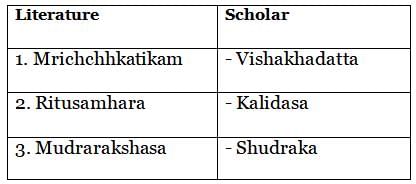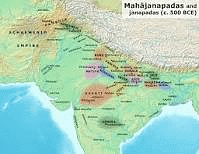HPPSC HPAS Prelims Paper 1 Mock Test - 10 - HPPSC HPAS (Himachal Pardesh) MCQ
30 Questions MCQ Test HPPSC HPAS Mock Test Series 2025 - HPPSC HPAS Prelims Paper 1 Mock Test - 10
Consider the following regions of ancient Indian history:
1. Kosala
2. Magadha
3. Gandhara
4. Avanti
5. Panchala
Which of the above was/were the ‘Mahajanapadas’?
Sangam texts cover the social evolution of Tamil people. In this context, which of the following statements given below is/are not correct?
1. The narrative texts show that early Tamil people were primarily pastoral.
2. No reference to trade and economic activities has been made in these texts.
Select the correct answer using the code given below:
Consider the following statements:
Ajivikas were fatalists who believed that everything was predetermined.
Lokayatas were materialists who rejected the authority of the Vedas.
Makkhali Gosala was an Ajivika teacher and Ajita Kesakambalin was a lokayata teacher.
Which of the statements given above is/are correct?
Ajivikas were fatalists who believed that everything was predetermined.
Lokayatas were materialists who rejected the authority of the Vedas.
Makkhali Gosala was an Ajivika teacher and Ajita Kesakambalin was a lokayata teacher.
Which of the following steps were taken by rulers in the medieval times to earn support of their subjects?
Declaring their close relationship with god through titles like “Shadow of God”.
Constructing public buildings like markets and water tanks.
Offering patronage to the learned and pious people.
Select the correct answer using the code given below.
Consider the following statements regarding Sultan Mahmud of Ghazni
- He entrusted a scholar, Al-Biruni to write an account of the subcontinent.
- Sultan Mahmud of Ghazni was a contemporary of Rajendra I.
- The Chahamana ruler Prithviraja III defeated an Afghan ruler named Sultan Mahmud of Ghazni.
Which of the statements given above are correct?
With reference to the Indus Valley Civilization, which one of the following statements is not correct?
With reference to Medieval India, consider the following pairs :

Q. How many pairs given above is/are correctly matched?
Consider the following pairs with reference to the cultural History of India :

How many pairs given above is/are correctly matched ?
Which of the following statements is/are correct about the currency reforms of Muhammad-Bin-Tughlaq?
1. Token currency was introduced for the first time ever in the history during his reign.
2. He introduced a bronze coin with the same value as the silver tanka.
Select the correct answer using the code given below:
In the context of mural paintings in ancient India, consider the following statements:
1. Paintings at the Kanchipuram temple were patronised by the Pallavas.
2. Paintings at Jaina caves in Sittanavasal were patronised by the Pandyas.
3. Mural painting as an art declined during the reign of the Cholas.
Which of the statements given above is/are Correct?
Who established the “Atmiya Sabha” a precursor in the socio-religious reforms in Bengal?
Consider the following statements:
1. In 1863, Satyendra Prasad Sinha became the first Indian to qualify for the Indian Civil Service.
2. The Indian Police Act, 1861, created a setup for an All India Police.
3. The 1853 Charter Act ended the Company’s patronage, enjoining recruitment to be through an open competition.
Which of the statements given above is/are Correct?
With reference to Colonial powers in India, arrange the following treaties in chronological order:
Treaty of Aix-La Chapelle
Treaty of peace of Paris
Treaty of Ryswick
Select the correct answer using the code given below:
Consider the following statements with respect to Simon Commission:
All the members of the Commission were Englishmen.
The Commission was appointed to go into the question of further constitutional reforms in British India.
The Simon Commission report recommended dominion status for British India.
Which of the statements given above are correct?
Consider the following pairs :
Places - Historical events
1. Varanasi - Annie Besant established the Central Hindu College
2. Mathura - A temple dedicated to Mother India was inaugurated by Mahatma Gandhi.
3. Bardoli - Withdrawal of Non Cooperation Movement
4. Lucknow - An armed robbery was organized by ten revolutionaries of the Hindustan Republic Association
How many pairs given above is/are correctly matched ?
Consider the following pairs:
Organisation : Associated member
1. The Bombay Presidency Association : Badruddin Tyabji
2. Madras Mahajan Sabha : Subramaniya Aiyer
3. The Bangabhasha Prakasika Sabha : Raja Ram Mohan Roy
Which of the pairs given above are correctly matched?
Which of the following statements is/are correct regarding the Pitt's India Act, 1784?
1. The Board of Control was established.
2. The orders of the Board of Control became binding on the Court of Directors.
3. The number of members in the Governor General's Council was reduced.
Select the correct answer using the code given below.
Which of the following statements is/are correct regarding the Karachi Session of 1931?
1. The Congress met in this Session to endorse the Gandhi-Irwin Pact.
2. For the first time, Congress defined what Swaraj would mean for the masses.
3. The Resolution on Fundamental Rights and the National Economic Programme were passed.
Select the correct answer using the code given below:
Which of the following statements is/are correct?
1. Harijan Sevak Sangh was founded by Mahatma Gandhi.
2. Gandhiji‟s Harijan campaign included promotion of education, cleanliness and hygiene.
3. After the Poona Pact, Gandhiji decided to commence an „Untouchability Prevention Movement‟.
Select the correct answer using the code given below:
Arrange the following events into chronological order
1. The Communist Party of India (CPI) was formed in Tashkent by M.N. Roy.
2. Hindustan Republican Association/Army was founded in Kanpur by Ram Prasad Bismil and others.
3. Chittagong Armoury Raid was conducted under the banner of Indian Republican Army- Chittagong Branch led by Surya Sen.
4. Bhagat Singh, Rajguru and Sukhdev were Hanged.
Select the correct answer using the code given Below:
Consider the following statements:
1. Forest area is the area notified and recorded as the forest land irrespective of the existence of trees.
2. Forest cover is the area occupied by forests with canopy.
3. Both the forest area and forest cover are based on the records of State Revenue Department.
Which of the statements given above is/are correct?
With reference to the process of Denudation, consider the following statements:
Frost is an agent of Erosion.
Wind is an agent of both weathering and erosion.
Which of the statements given above is/are correct?
Consider the following statements with respect to Tsunami:
They are caused by the vertical displacement of oceanic plates.
The speed of the Tsunami wave depends on the depth of the water.
The impact of the Tsunami wave is less in the mid-ocean compared to the coast.
Which of the statements given above are correct?
With reference to the world population, consider the following statements:
The world population crossed the one billion mark in the first half of the 17th century.
At present, Africa has the highest growth rate of population among all the continents.
Which of the statements given above is/are correct?
Consider the following pairs: Relief Features Physiographic division
1. Karewas : Kashmir Himalayas
2. Barchans : Great Himalayan range
3. Bugyals : Great Indian Desert
Which of the pairs given above is/are correctly matched?
Consider the following pairs:

Which of the pairs given above is/are correctly matched?
Consider the following statements regarding alluvial soil
1. It is majorly found in northern plains of India.
2. Khadar soil is known as old alluvial soil.
3. Bangar soil is more fertile than kadar.
Which of the statements given above is/are correct?
Consider the following statements:
There are nine coastal states in India.
The nodal ministries for the coastal region are the Ministry of Environment, Forests and Climate Change (MoEF&CC), and Ministry of Earth Sciences (MoES).
Which of the statements given above is/are correct?
The amount of insolation received at the earth’s surface depends on:
Angle of the sun’s radiation
Length of the day
Distance between the sun and the earth
Sunspots
Effects of the atmosphere
Select the correct answer using the code given below.
Consider the following statements with reference to the occurrence of various minerals:
Metallic minerals are obtained from veins and lodes.
Coal mainly occurs as alluvial deposits in the sands of valley floors.
Bauxite is formed as a result of an accumulation for long periods under great heat and pressure.
Which of the statements given above is/are correct?




















